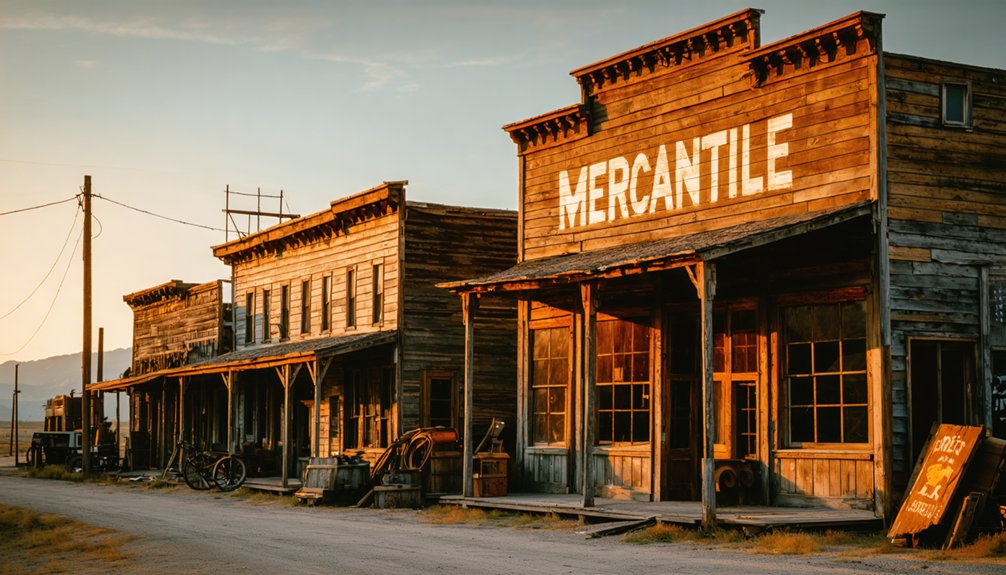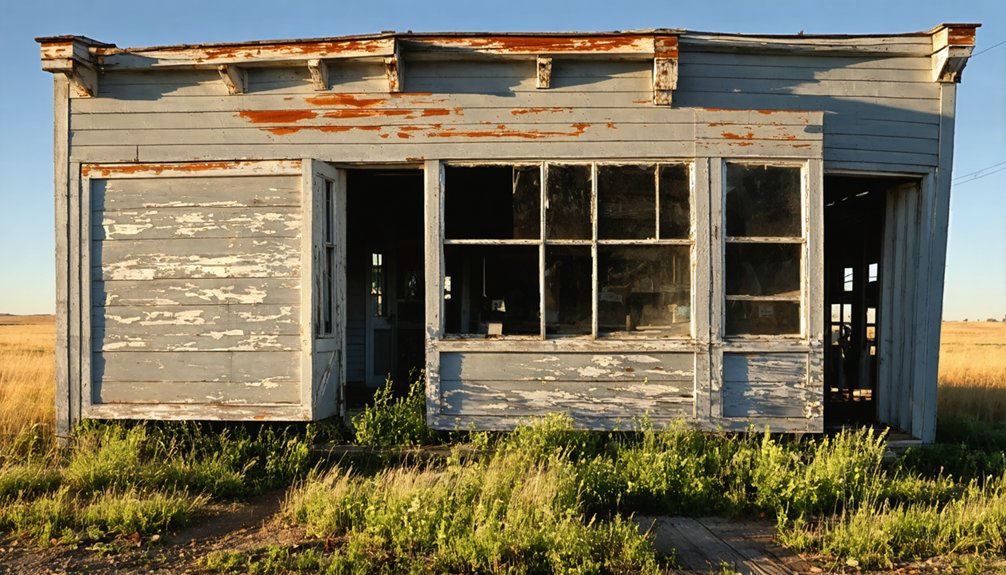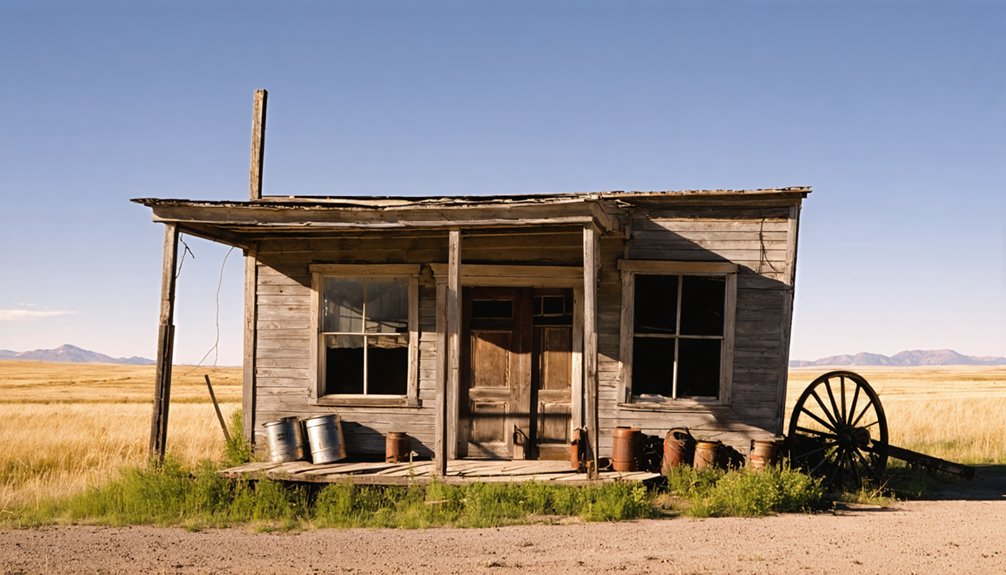You’re looking in the wrong state – Diamond City was actually a Montana Territory gold mining boomtown located in Confederate Gulch. During its peak in the 1860s, the town reached 10,000 residents and saw daily gold yields worth up to $100 per miner. Named for its four founding log cabins arranged in a diamond pattern, it served as Meagher County’s first seat before declining when gold deposits ran out. The town’s fascinating history of vigilante justice and economic prosperity tells a deeper story of the American West.
Key Takeaways
- Diamond City should not be confused with South Dakota ghost towns, as it was located in Montana Territory.
- The town was named for its four original log cabins arranged in a diamond pattern during Montana’s gold rush era.
- At its peak, Diamond City reached 10,000 residents and served as Meagher County’s first seat in Montana Territory.
- The town declined rapidly in the late 1860s when gold deposits were depleted, leading to mass exodus.
- Unlike many preserved ghost towns, Diamond City’s physical remnants are minimal, with history primarily preserved through documents.
Historical Correction: Montana’s Lost Mining Haven
While many associate Montana’s mining history primarily with Butte’s copper empire, the state’s rich mining heritage extends deep into the Garnet Mountains, where numerous mining settlements once thrived.
Montana’s mining legacy stretches far beyond Butte, reaching into the remote Garnet Mountains where forgotten boomtowns tell tales of frontier dreams.
You’ll find that mining nostalgia runs particularly strong at Garnet Ghost Town, where buildings still stand without foundations, a reflection of the transient nature of these frontier communities. The town reached its peak with nearly 1,000 residents in January 1898. As miners chased gold-bearing quartz veins through the rugged terrain, they established temporary homes that would later become historical treasures. During the late 1890s, many professional miners departed for the promising Klondike gold fields.
When the Sherman Silver Purchase Act‘s repeal shook the industry, miners shifted their focus from silver to gold, adapting their techniques from simple panning to more sophisticated methods.
Despite challenging conditions and limited infrastructure, these determined prospectors carved out a remarkable chapter in Montana’s mining story.
The Gold Rush That Started It All
Lieutenant Colonel George Armstrong Custer’s 1874 expedition into the Dakota Territory forever changed the American frontier when his team confirmed the presence of gold in the Black Hills region.
While officially a military mapping mission, civilian miners in Custer’s party found placer gold deposits along French Creek, igniting a surge of fortune-seeking prospectors despite the 1868 Fort Laramie Treaty protecting Sioux lands.
These intrusions into tribal territory led to escalating Indian Wars and bloodshed.
Much like the Confederate Gulch district, this discovery sparked an intense gold rush that would transform the region and draw thousands of hopeful miners.
Life in a Booming Mining Community
You’ll find a fascinating glimpse into Diamond City’s daily life during Montana Territory’s Confederate Gulch gold rush, where miners earned up to $100 per day working claims in the late 1860s.
The town’s population swelled to 10,000 residents who supported the mining economy through diverse businesses like supply stores, saloons, and the essential Enos stamp mill for ore processing.
Despite the promising wages and economic activity, Diamond City’s prosperity proved short-lived, as aggressive hydraulic mining practices literally undermined the town’s foundations while depleting the gold deposits by 1869. Named after four log cabins arranged in a diamond pattern in the snow, the settlement quickly grew into Montana’s largest community during the mining boom.
Like other mining settlements of its era, Diamond City featured a stamp mill operation, similar to those found in numerous Black Hills mining towns.
ERROR: Location Incorrect in Blog Post Title. Diamond City Was in Montana, Not South Dakota
A common misconception in several blog posts and online articles incorrectly places Diamond City in South Dakota, when historical records clearly establish its location in Confederate Gulch, Montana, along the western slope of the Big Belt Mountains.
You’ll find extensive documentation proving Diamond City’s Montana origins, including mining district records, territorial maps, and historical accounts from the 1860s gold rush era.
The town’s diamond discovery began in late 1864 when prospectors Jack Thompson, Washington Baker, Fountain M. Dennis, and John Wells struck gold in Confederate Gulch.
Their mining techniques, particularly hydraulic mining, helped establish Diamond City as Montana Territory’s most populous camp by 1866. The remarkable Montana Bar produced up to $1,000 per pan of gold during peak mining operations.
The town even served as Meagher County’s first seat, firmly cementing its place in Montana’s history, not South Dakota’s. Like the fate of Nevada City, Diamond City experienced a rapid decline into abandonment after its mining heyday.
Suggested Subheading Discussion Points for “Life in a Booming Mining Community”
Life in Diamond City during its boom years painted a vivid picture of Montana Territory’s most dynamic mining settlement, where thousands of prospectors and settlers carved out their existence in Confederate Gulch between 1864 and 1869.
You’d have found a diverse community dynamics at play, with both Union and Confederate sympathizers coexisting in this rugged frontier town. The average miner was just 27 years old, bringing youthful energy to the settlement. German immigrants led by Charles Fredericks arrived in 1865, discovering the rich Montana Bar.
Social challenges emerged as the population swelled to 5,000, leading to claim jumping and theft that spurred the formation of vigilante committees. You’d have witnessed cattle ranchers establishing themselves alongside miners, while the community dealt with the physical instability caused by hydraulic mining.
A single gold shipment could exceed $900,000, showing the incredible wealth flowing through this bustling settlement.
Daily Work and Wages
While prospectors dreamed of striking it rich in Diamond City’s gold-laden gulches, the daily reality involved grueling 10-to-12-hour shifts in hazardous conditions.
You’d find yourself working underground in dark, confined spaces, facing constant work hazards like cave-ins and respiratory problems from dust exposure.
If you’d landed a job as a miner, you’d earn competitive wages for the era, with recent comparable positions paying around $26.84 per hour in South Dakota.
The region now ranks as the lowest paying state for mining work in America.
Pay disparities existed between roles, with skilled miners and supervisors earning up to 40% more than general laborers.
You could boost your earnings through productivity bonuses based on ore extraction.
While the work was physically demanding, your wages would support local businesses and help build Diamond City’s infrastructure, creating a ripple effect throughout the community.
Peak Years and Economic Prosperity

Despite extensive research into the Black Hills region‘s mining history, specific details about Diamond City’s peak years remain elusive, as historical records don’t conclusively document a ghost town by this name in South Dakota.
What we do know is that the Black Hills region flourished during the 1874 Gold Rush, when mining techniques evolved and settlements rapidly developed to support the growing industry.
You’ll find that these towns typically established crucial infrastructure, including schools, stores, and social venues to serve the mining communities.
The economic prosperity of ghost towns in this area was closely tied to mineral availability and market demands.
While Diamond City’s specific contribution to the local economy isn’t documented, the broader region’s mining towns served as key hubs for commerce and community life during their peak years.
Environmental Impact of Hydraulic Mining
Throughout the late 19th century, hydraulic mining operations in mining regions like Diamond City inflicted severe environmental damage that continues to impact ecosystems today.
You’ll find that massive sediment accumulation from these operations choked rivers and streams, causing riverbeds to rise dramatically and triggering increased flooding in downstream communities.
The environmental toll didn’t stop there – miners used vast quantities of mercury to extract gold, losing roughly half of it to the environment. This mercury pollution has persisted in soils and waterways for over a century, contaminating wildlife and exceeding EPA safety standards.
The landscape bears permanent scars, with eroded hillsides, barren debris fields, and disrupted water systems that still haven’t recovered.
These impacts have permanently altered the region’s hydrology and ecosystem health.
The Vigilante Era and Law Enforcement

Diamond City’s lawless frontier conditions gave rise to one of the American West’s most notable vigilante movements in the 1860s. With limited territorial law enforcement and challenging remote terrain, citizens often took justice into their own hands.
- You’d find vigilante justice particularly active in regions where sheriffs and judges lacked resources to maintain order.
- The lack of infrastructure made it difficult for law enforcement to respond quickly to criminal activities.
- Public executions served as both punishment and deterrent, with suspected horse thieves frequently targeted.
- Local newspapers shaped public perception, often portraying vigilantes as necessary peacekeepers.
This era of frontier justice created what became known as the Pax Vigilanticus – a period of relative peace born from the fear of swift, citizen-delivered punishment.
The legacy of these vigilante movements continues to spark debate among historians studying Western American justice.
Decline of a Once-Thriving Settlement
When gold deposits began to dwindle in the late 1860s, the once-bustling Confederate Gulch mining district watched its crown jewel fade into obscurity.
Diamond City’s fate was sealed by its singular focus on mining, leaving no economic safety net when the precious metals ran dry. The aggressive mining techniques, particularly hydraulic mining, had ravaged the landscape and compromised the town’s infrastructure.
A town built solely on gold’s promise crumbled when the mines went dry, destroyed by the very industry that birthed it.
You would’ve witnessed a mass exodus as miners and their families sought opportunities elsewhere, leading to a rapid deterioration of community services.
The town’s decline proved swift and irreversible – a stark reminder of the boom-and-bust cycle that defined many Western mining settlements.
Today, Diamond City’s community legacy lives on primarily through archived documents and its status as a symbol of the fleeting nature of gold rush prosperity.
Remnants and Ruins Today

Modern visitors searching for Diamond City’s physical remnants will find their quest unfulfilled. Unlike other Black Hills ghost towns that maintain visible ruins, Diamond City’s complete demolition in 1967 erased virtually all traces of its existence.
The site’s archaeological significance remains unexplored, with no documented excavations or preservation efforts since its destruction.
- No structures, foundations, or mining equipment survive at the barren location
- Historical documentation, rather than physical artifacts, preserves the town’s legacy
- The area has reverted to empty fields, typical of abandoned mining settlements
- You won’t find any historical markers or interpretive signs at the original townsite
The site stands in stark contrast to neighboring ghost towns like Galena and Trojan, where you can still explore tangible connections to the region’s mining past.
Preserving Diamond City’s Mining Heritage
You’ll find that Diamond City’s location in Montana Territory, not South Dakota, is a critical distinction when examining preservation efforts of this Confederate Gulch mining settlement.
While the Black Hills Mining Museum offers valuable insights into mining heritage preservation techniques, these practices need to be contextualized specifically for Montana’s distinctive mining history and Diamond City’s unique circumstances.
The preservation frameworks and community engagement models mentioned in the facts can be adapted to Diamond City’s particular needs, but must account for Montana’s different historical, geological, and cultural mining landscape.
ERROR in TITLE: Diamond City Was in Montana, Not South Dakota
Despite widespread misconceptions placing Diamond City in South Dakota, historical records definitively establish this legendary mining boomtown‘s location in Montana’s Confederate Gulch, approximately 40 miles east of Helena.
You’ll find that ghost town myths and historical inaccuracies have led to confusion about this once-thriving mining settlement.
- The town emerged in 1864-1865 after gold discoveries by Jack Thompson and his partners.
- Diamond City peaked at 10,000 residents, becoming Montana’s most populous mining camp in 1866.
- The site produced remarkable gold yields, including a single 2-ton shipment valued at $900,000.
- Hydraulic mining ultimately destroyed the town’s physical remnants, leaving few traces today.
It’s essential to correct this geographical error to properly preserve Montana’s mining heritage and direct public interest to the authentic location.
Correct Subheading Discussion Points
Preserving Diamond City’s mining heritage presents unique challenges, given that hydraulic mining operations virtually erased the original townsite.
You’ll find that preservation efforts now focus on mining equipment artifacts, archival documents, and oral histories rather than standing structures. While the original buildings are gone, you can explore the extensive documentation of tailings, dredging sites, and placer mining operations throughout Confederate Gulch.
Local museums and historical societies have stepped up to protect this legacy through multimedia exhibits and interpretive trails.
You’re able to access detailed mining records, early maps, and family stories that bring Diamond City’s 1860s gold rush era to life. Through these efforts, you’ll discover how this Montana boomtown grew to over 5,000 residents before declining into a ghost town by the 1880s.
Frequently Asked Questions
What Happened to the Gold Mining Equipment After Diamond City Was Abandoned?
You’ll find that abandoned gold equipment either got repurposed for other mining operations or was left to deteriorate naturally, creating a mining legacy that’s still visible in Montana’s Confederate Gulch today.
Were There Any Notable Murders or Crimes That Occurred in Diamond City?
You won’t find documented murder mysteries or crime history for this location, as there’s no reliable historical record of notable crimes from a Diamond City in South Dakota.
Did Any Famous Historical Figures Ever Visit Diamond City?
Like footprints in the desert sand, you won’t find traces of famous visitors in the historical records. No documented evidence exists of any notable historical figures visiting this remote mining boomtown.
What Was the Average Daily Wage for Miners in Diamond City?
You’ll find mining economics varied greatly, with daily wage fluctuations ranging from $3-20 depending on claim success. There’s no exact average recorded, but miners typically earned based on their gold yields.
Were There Any Natural Disasters That Affected Diamond City’s Development?
You’ll find that flood impacts from the Black Hills region’s frequent flash flooding and potential fire hazards in the mountainous terrain likely affected development, though specific records for Diamond City aren’t well documented.
References
- https://www.sdpb.org/rural-life-and-history/2023-08-21/some-black-hills-ghost-towns-and-their-origins
- https://www.sdhspress.com/journal/south-dakota-history-2-2/some-black-hills-ghost-towns-and-their-origins/vol-02-no-2-some-black-hills-ghost-towns-and-their-origins.pdf
- https://www.youtube.com/watch?v=Bl2mT_h9Hig
- https://www.blackhillsbadlands.com/blog/post/old-west-legends-mines-ghost-towns-route-reimagined/
- https://westernmininghistory.com/towns/montana/diamond-city/
- https://photoseek.com/2011/usa-montana-ghost-towns-history/
- https://en.wikipedia.org/wiki/List_of_ghost_towns_in_South_Dakota
- https://blackhillsatvdestinations.com/ghost-towns/
- https://www.garnetghosttown.org/history.php
- https://npshistory.com/publications/usfs/region/1/flathead/history/chap3.htm



